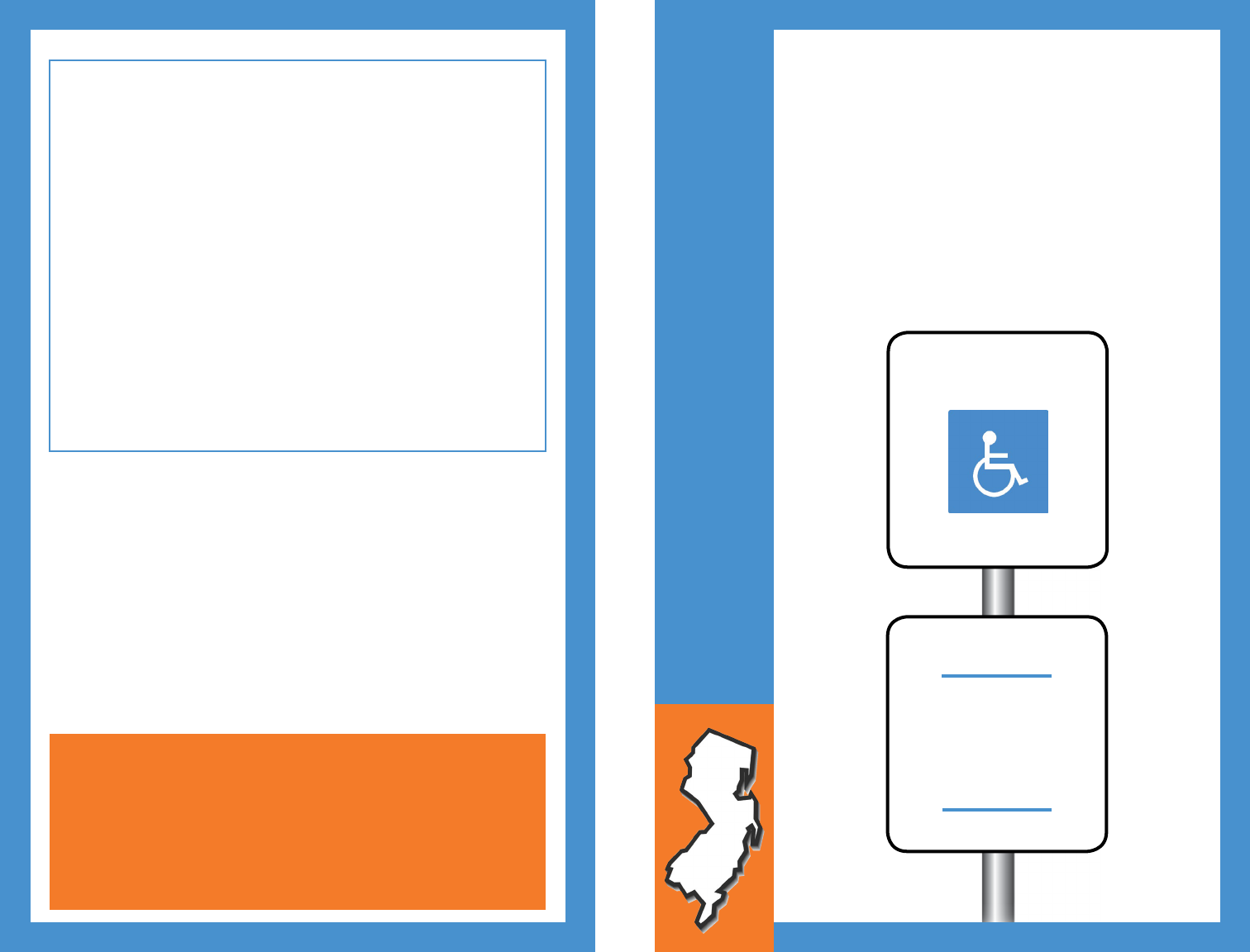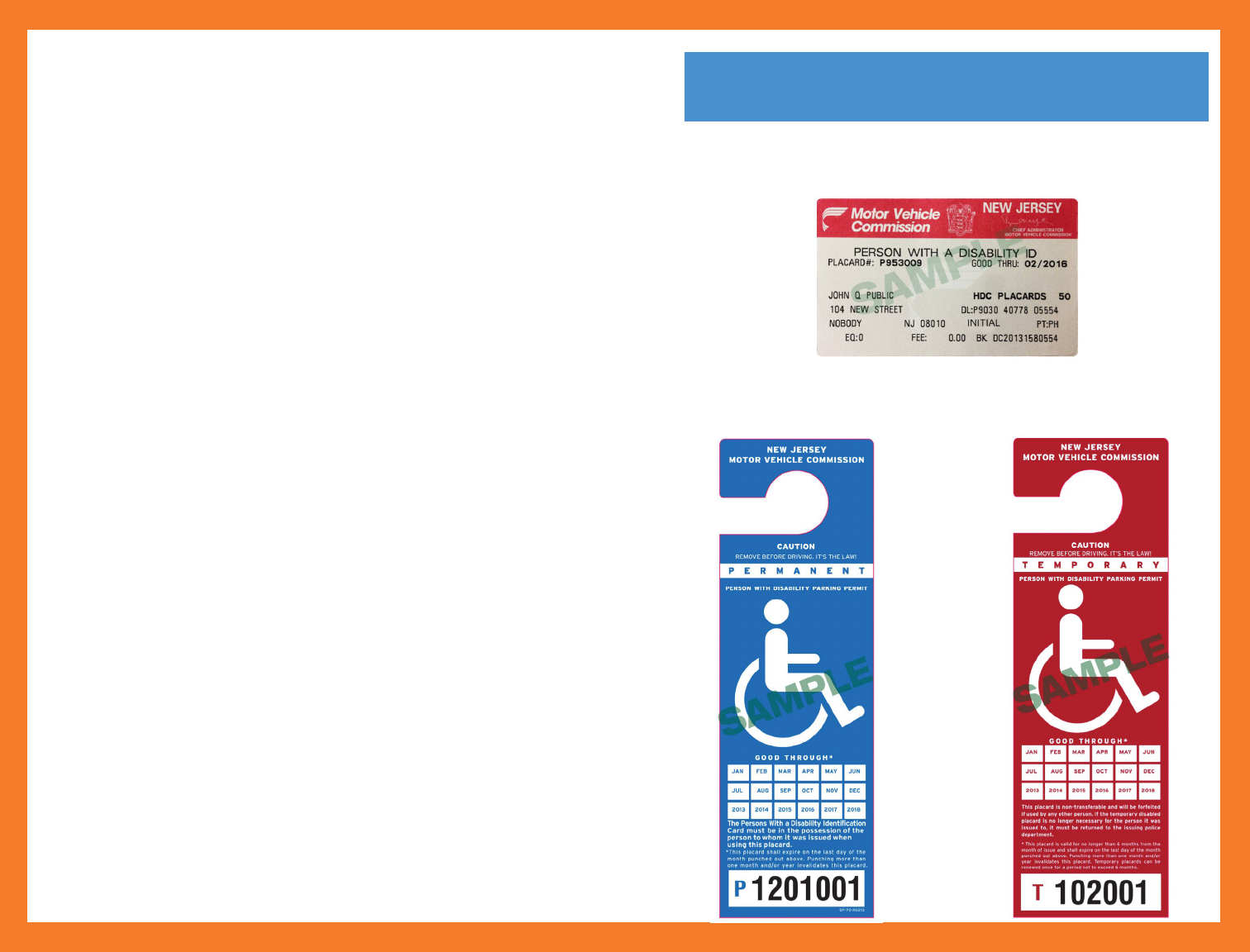
NEW JERSEY
GUIDE TO
ACCESSIBLE
PARKING
RESERVED
PARKING
STATE DISABLED PARKING
PERMIT REQUIRED
PENALTY
$250-FIRST OFFENSE
SUBSEQUENT
OFFENSES
$250 MINIMUM
AND/OR UP TO 90 DAYS
COMMUNITY SERVICE
TOW-AWAY ZONE
PARKING THERE FOR “JUST A MINUTE . . .”
is 60 SECONDS TOO LONG!
Never park in a space reserved for people with
disabilities UNLESS you have a Person with a
Disability Identification Card and identifying
placard/plates. It’s the courteous thing to do - -
and it’s the law.
REMEMBER: Do not park in the striped access
aisles next to spaces reserved for people with
disabilities, even if you have a placard or plates.
The access aisles provide room for wheelchair
users to transfer safely to and from their vehicles.
This publication is designed as a resource only;
it is not a substitute for the law or statute
related to accessible parking.
State of New Jersey
Phil Murphy, Governor
Sheila Oliver, Lt. Governor
Department of Human Services
Carole Johnson, Commissioner
Produced by the NJ DHS

• Temporary Placards (see Fig. 3) can be granted for short-term
mobility impairments. Written medical certication from a
qualied practitioner is required. Temporary Placards are valid
for six months, renewable once at the discretion of the issuing
authority, and issued by the chief of police of each municipality.
(C.39:4-206)
• Parking motor vehicles in accessible spaces without special
vehicle identication is prohibited and punishable with an initial
ne of $250 and subsequent nes of at least $250 and up to 90
days of community service. (C.39:4-197(3)c)
• Municipalities may establish accessible spaces in front of
residences, schools, hospitals, public buildings, and in shopping
and business districts. (C.39:4-197.5)
• Municipalities may establish accessible parking zones in front
of residences occupied by people with disabilities, unless such
parking interferes with the normal trafc ow. (C.39:4-197.6)
• Law enforcement ofcers may enforce accessible parking laws
on both public and private property. (C.39:4-138.o)
• Municipalities may set up parking enforcement units that
concentrate on shopping centers and malls. (C.39.4-197.9)
• Eligible individuals with a disability may request law
enforcement ofcers to arrange for the removal and storage of
motor vehicles unlawfully parked in accessible parking spaces
or zones. (C.39:4-207.7)
• Access to parking spaces, curb cuts, or other improvements
designed to provide accessibility, shall be unobstructed. Owners
or controllers of public parking areas must remove snow or ice
from these areas within 24 hours after the weather condition
causing the snow and/or ice ceases. Violation of this act is
punishable with penalties of $500 to $1,000. (C.394:4-207.9)
GUIDE TO ACCESSIBLE PARKING
GUIDE TO ACCESSIBLE PARKING
2 3
Editors Note: Although state law uses the term
“handicapped” parking, the word “handicapped” has been
changed to “accessible” throughout this guide to reflect
person-first language.
Reserved parking for people with disabilities ensures safe and
equal access to goods and services. Accessible parking makes it
possible for individuals with a disability to use and benet from
the services offered by public and private entities.
Accessible parking requirements in New Jersey are a
combination of New Jersey statutes and Americans with
Disabilities Act (ADA) standards.
• Every application for the issuance or
renewal of a “Person with a Disability
Identication Card” (see Fig. 1), required
every three years, must include medical
certication from a qualied practitioner that
the qualifying disability continues to exist. (C.39:4-205)
• The individual who holds the “Person with a Disability
Identication Card” must be in the vehicle or with the driver at
all times as proof of disability. This card is for the sole use of the
individual with a disability and is non—transferable. Abuse or
misuse of this privilege will be cause for immediate revocation
of the ID card, placard and plates and nes of at least $250.
(C.39:4-205)
• Permanent Placards (see Fig. 2) are required to be renewed every
three years and will clearly display the date on which they shall
become invalid. (C.39:4-206)
HIGHLIGHTS OF ACCESSIBLE PARKING
IN NEW JERSEY

GUIDE TO ACCESSIBLE PARKING
GUIDE TO ACCESSIBLE PARKING
4 5
PERSON WITH A DISABILITY ID CARD
AND PLACARDS
• No penalty shall be imposed on those with valid “Person with
a Disability Identication Cards” for overtime parking in one
location for up to 24 hours, as long as the person with the
disability is either the driver or passenger of the vehicle. (C.39:4-
207)
(Note: metered parking is delegated to local municipalities by
N.J.S.A. 39:4-197; The 24 hour limit is set forth in N.J.S.A. 39:4-
207)
ADA STANDARDS OUTLINE THE FOLLOWING:
• Accessible parking spaces must be identied by signs that
include the International Symbol of Accessibility.
• Access aisles must be marked.
• An accessible route must adjoin each access aisle serving
accessible parking spaces. The accessible route connects each
access aisle to accessible entrances.
• Accessible parking spaces must be located on the shortest
accessible route of travel to an accessible entrance.
• Accessible parking spaces and the required accessible route
should be located where individuals with disabilities do not
have to cross vehicular lanes or pass behind parked vehicles
to have access to an accessible entrance. If it is necessary to
cross a vehicular lane - for example, perhaps local re access
requirements prohibit parking immediately adjacent to a building
- then a marked crossing running perpendicular to the vehicular
route should be included as part of the accessible route to an
accessible entrance.
• One in every six accessible parking spaces must be van
accessible.
FIGURE 1:
Person with a Disability
Identification Card
FIGURE 2:
Permanent Person with a
Disability Placard
FIGURE 3:
Temporary Person with a
Disability Placard

• Striped access aisles adjacent to accessible parking spaces.
• Parking meters without depositing a coin.
• Parking meters beyond a 24-hour period.
• Other areas prohibited by law including within an intersection,
on a crosswalk, in any area appropriately marked “no parking,”
within 50 feet of a stop sign or within 10 feet of a re hydrant.
Remember: Restricted parking placards and plates are to be used
solely by the individual with the qualifying disability. If someone
without a disability uses another person’s placard or plates, the
Motor Vehicle Commission or issuing locality may revoke the
placard/plates, deny renewal, and issue nes of at least $250.
GUIDE TO ACCESSIBLE PARKING
GUIDE TO ACCESSIBLE PARKING
6 7
Q: How many accessible parking spaces are required?
A: The number of accessible parking spaces required depends on
the total number of parking spaces in the lot or garage.
In accordance with the ADA standards of accessible design,
when there is new construction or an alteration of previously
constructed parking spaces, it is required that at least one
accessible space in every parking lot and one in every six
accessible parking spaces be van accessible, with increased
dimensions of at least 11 feet and an access aisle of at least 5
feet.
PLACARD OR PLATE HOLDER CANNOT PARK
IN THE FOLLOWING AREAS:
• Owners or operators of any facility that provides public parking,
whether an indoor or outdoor garage or parking lot, are required
to provide accessible parking in accordance with federal and
state laws. Enforcement of motor vehicle laws, including parking
privileges, is a local matter.
WHAT ARE BUSINESS OR FACILITY OWNERS
AND OPERATORS REQUIRED TO DO?
• Ask a state, county or municipal law enforcement ofcer to
ticket an illegally parked car and to arrange for the removal and
storage of the vehicle.
• Complain to a shopping center manager or business owner. Ask
them to inform the local authorities.
• File a complaint with your local municipality.
COMPLAINTS ABOUT ILLEGAL
PARKING...WHAT CAN BE DONE?
FREQUENTLY ASKED QUESTIONS
Total # spaces
1-25
26-50
51-75
79-100
101-150
151-200
201-300
301-400
401-500
51-1,000
Over 1,000
Required # of
accessible spaces
At least 1 in
each lot
1
2
3
4
5
6
7
8
9
2% of total
20 + 1 for each
100 over 1,000
Required # of
accessible van
spaces if
constructed or
altered prior to
3/15/2012
1:8
1
1
1
1
1
1
1
1
2
1 in every 8
1 in every 8
Required # of
accessible van
spaces if
constructed
or altered on or
after 3/15/2012
1:6
1
1
1
1
1
1
2
2
2
1 in every 6
1 in every 6

GUIDE TO ACCESSIBLE PARKING
GUIDE TO ACCESSIBLE PARKING
8 9
Q: How must accessible parking spaces and access aisles be
marked?
A: The parking spaces and access aisles must be painted in a color
(most often blue) contrasting with other spaces. Signage with
the International Symbol of Accessibility and the penalty sign
must be provided at each accessible parking space and must
be permanently installed 5 to 7 feet above the ground. Signs
identifying van parking spaces shall contain the designation
“van accessible.” The required “van accessible” designation is
intended to be informative, not restrictive, in identifying spaces
that are better suited for van use. The access aisle for both
accessible car and van spaces is required to be a minimum of 5
feet wide. Access aisles shall adjoin an accessible route, shall
be marked to discourage parking in them, and shall extend the
full length of the parking spaces they serve. Also, two parking
spaces may share a common access aisle.
Q: Can accessible parking spaces
be the same size as non-
accessible spaces, as long as
the appropriate signs are
placed in front of the space?
A: No. Accessible car parking
spaces must be at least 8 feet
wide. Accessible van parking
spaces must be at least 11 feet
wide. The access aisle for both accessible car and van spaces
is required to be a minimum of 5 feet.
Q: If a parking lot does not have spaces designated for people
with disabilities because it was paved a long time ago,
before these requirements were in place, does it now have
to provide accessible parking spaces?
A: Yes. The ADA requires private entities to remove barriers to
become compliant. Therefore, even if business owners are not
planning any type of construction, they are still obligated to
remove barriers that are readily achievable.
Q: Is my wheelchair symbol license plate/placard valid when
traveling outside of New Jersey?
A: Not always. Check with the state you intend to visit. Reciprocity
is standard for some but not all states. For example, a New
Jersey placard/pate is not valid on New York City streets, as
NYC requires their own accessible parking permit. However,
a motor vehicle with a special license plate, placard or parking
permit issued to a person with a disability by another state,
district or territory of the United States or by Canada shall be
entitled to accessible parking privileges in New Jersey. (39:4-
207.5)
Q: Store owners and other businesses often receive complaints
from patrons about other customers who illegally park
in the accessible parking spaces or misuse the spots by
parking in the stripped area next to the space. What should
they do?
A: Instances in which individuals illegally park in a space marked
for accessible parking should be reported to the proper law
enforcement authorities. In your area, if the local police are
responsible for addressing violations, they should be notied
as soon as possible. If a local security company staff patrols
your parking area, they should be notied.
Q: Is a person with a wheelchair symbol license plate/placard
required to deposit money when parking at a metered
space?
A: Yes. When parking at a metered space, a driver with a disability
placard/license plate must put the appropriate amount of
money in the meter. If the vehicle will occupy the space for

GUIDE TO ACCESSIBLE PARKING
GUIDE TO ACCESSIBLE PARKING
10 11
FOR MORE INFORMATION
PO Box 705 Trenton, NJ 08625-0705
1-888-285-3036
www.state.nj.us/humanservices/dds/home/index.html
New Jersey Motor Vehicle Commission
Special Plate Unit
225 East State Street
PO Box 15
Trenton, NJ 08666-0015
609-292-6500
www.state.nj.us/mvc/vehicles/disability.htm
ADA Information Line
1-800 514-0301 (Voice)
1-800-514-0383 (TTY)
www.ADA.gov
more than the maximum amount of time allotted on the meter,
the driver must ll the meter to the maximum amount allowed.
This will permit the vehicle to occupy the space for up to 24
hours without having to come back and rell the meter. A
municipality may require the vehicle to vacate the space after
24 hours.
(Note: metered parking is delegated to local municipalities
by N.J.S.A. 39:4-197; The 24 hour limit is set forth in
N.J.S.A. 39:4-207)
Q: How can I apply for a person with a disability license
plate or permanent placard?
A: The application and instruction checklist can be
obtained on the Motor Vehicle Commission website
at: www.state.nj.us/mvc/vehicles/disability.htm;
by visiting your nearest Motor Vehicle Commission
facility; or by calling the Motor Vehicle Commission
at 609-292-6500 and requesting that they be
mailed to you. The same application is used for
first-time (initial), renewal, and replacement plate
and permanent placard requests. A “Person with
a Disability Identification Card” will be issued
following an initial application and must be used in
conjunction with a plate and/or permanent placard.
Qualified applicants receive one set of wheelchair
symbol license plates for a vehicle registered either
to the qualified person with a disability OR to one
family member who provides the qualified person
with transportation (aka driver).
